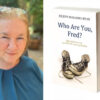These books will help you understand the suppression of free thought.
1. Banned in the U.S.A. by Herbert Foerstel

via pinterest.com
“Since the first edition was published to acclaim and awards in 1994, librarians have relied on the work of noted intellectual freedom authority Herbert N. Foerstel.”
2. The Autobiography of Satan (Authorized Edition) by William A. Glasser

via amazon.com
This is the story of Satan’s many struggles, across the history of Human existence, to unshackle the Human mind, and open the gates to forbidden knowledge.
From the moment of his first emergence as a single spark in the dimness of prehistory, to the more enlightening force into which he evolves across the full span of human existence, Satan, as he now clearly illustrates, has been urging human beings to open their eyes to the world around them, and to continue seeking, with unfettered minds, for ultimate answers, yet to be found. To do so he must struggle against the persistent attempts to stifle that urge by the “spoon feeders,” as he calls them, individuals who have insisted, within every age, and often with a bloody fist, that they, and they alone, are the possessors of the only beliefs that every human being should accept and live by, without question. As Satan traces the history of their many attempts to stop human beings from thinking for themselves, he also takes his readers on a search for the ultimate source of all evil in this world. Readers will obviously enter the book with the standard concept of Satan as a supernatural figure of evil. They will leave the book, however, with a better understanding of how such mind-twisting concepts have been used to keep people away from the “forbidden” knowledge that lies beyond the borders of entrenched beliefs.
3. God and His Demons by Michael Parenti

via amazon.com
“A noted author and activist brings his critical acumen and rhetorical skills to bear in this polemic against the dark side of religion. Unlike some popular works by stridently outspoken atheists, this is not a blanket condemnation of all believers. Rather the author’s focus is the heartless exploitation of faithful followers by those in power, as well as sectarian intolerance, the violence against heretics and nonbelievers, and the reactionary political and economic collusion that has often prevailed between the upper echelons of church and state.”
4. Unlearning Liberty by Greg Lukianoff

via amazon.com
“For over a generation, shocking cases of censorship at America’s colleges and universities have taught students the wrong lessons about living in a free society. Drawing on a decade of experience battling for freedom of speech on campus, First Amendment lawyer Greg Lukianoff reveals how higher education fails to teach students to become critical thinkers: by stifling open debate, our campuses are supercharging ideological divisions, promoting groupthink, and encouraging an unscholarly certainty about complex issues.”
5. Anatomy of Censorship by Harry White

via amazon.com
“Bringing together diverse disciplines such as literary and legal history, modern psychology and contemporary feminism, Anatomy of Censorship sorts out the many confusing explanations and often misleading justifications for censorship to reveal the underlying conditions and motivations that lead to the suppression of various forms of communication. It explains why censors are notoriously incapable of identifying what defines obscene, immoral or illicit expression and how they actually profit from this failure on their part. It shows how censors ultimately aim not to define expression, but people: how they use censorship to stigmatize classes of people as more prone to corruption and depravity, and how they thereby seek to protect the authority of the few rather than, as they falsely claim, the morality of the many. Above all, it offers a timely critique of the most seductive and bogus justification for censorship: that expression has the capacity to cause actual harm. It shows how the law and the censor conspire to foster this unsupported fabrication in the face of overwhelming evidence that no causal link between expression and harm has ever been discovered.”
Receive top book recommendations directly in your inbox.






























Leave a Comment
Your email address will not be published. Required fields are marked with *